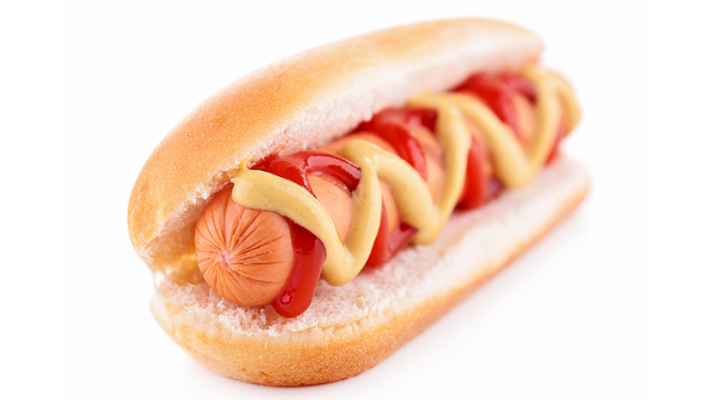Surprising sources of summer weight gain (and what to do!)
By Anne Palumbo
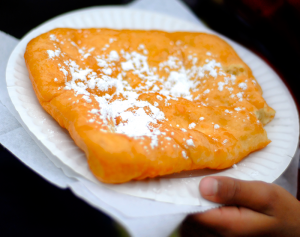 Now that the warm weather is here, a wonderful feeling comes across us: we want to eat lighter and fresher. An abundance of fresh summer produce certainly supports that desire. So hats off to farmers and farmers markets everywhere!
Now that the warm weather is here, a wonderful feeling comes across us: we want to eat lighter and fresher. An abundance of fresh summer produce certainly supports that desire. So hats off to farmers and farmers markets everywhere!
But summertime does not automatically equal healthier eating and living. Although people may wish to eat healthier during the summer months, there are “seasonal temptations” that can derail even the best intentions. These warm-weather temptations, many of them caloric to boot, are typically found at festivals, state and county fairs, barbecues and the occasional picnic. Here are some summer foods you want to avoid (or else consume in sincere moderation) and some healthier options for you to consider.
Fried dough: Consider roasted nuts or popcorn. Nothing kicks off the festival season quite like a big greasy plate of fried dough. Unbeknownst to many, these caloric bombs weigh in with about 800 calories and 44 grams of fat, some of which could be the dreaded trans fats. Rumor has it, fried dough’s evil twin, funnel cake, is just as bad. Sure, they’re often divvied up, but still! Figuring you left those carrot sticks at home, opt for sharing some protein-packed roasted nuts or fiber-rich popcorn (minus all the butter and salt, of course).
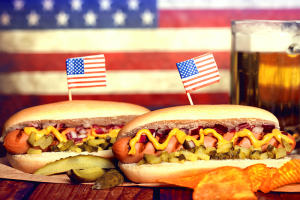 Frappuccino topped with whipped cream: Consider plain iced coffee. Oh, those frozen coffee drinks garnished with oodles of whipped cream: What would summer be without them? A lot less caloric, that’s what. Got a favorite? I did. But after discovering the sweet li’l thing had a waist-expanding 420 calories, 15 grams of fat and 66 grams of sugar, I switched over to plain iced coffee with some skim milk. On those occasions when only a frozen coffee drink will do, go for one made with nonfat milk and ditch the whipped cream: you’ll save hundreds of calories.
Frappuccino topped with whipped cream: Consider plain iced coffee. Oh, those frozen coffee drinks garnished with oodles of whipped cream: What would summer be without them? A lot less caloric, that’s what. Got a favorite? I did. But after discovering the sweet li’l thing had a waist-expanding 420 calories, 15 grams of fat and 66 grams of sugar, I switched over to plain iced coffee with some skim milk. On those occasions when only a frozen coffee drink will do, go for one made with nonfat milk and ditch the whipped cream: you’ll save hundreds of calories.
Creamy potato or pasta salads: Consider whole-grain salads. Stick-to-your-ribs foods like potatoes and pasta give us the slow-burning energy we need to stay warm in the winter. Come summer, however, we want to stay cool and light on our feet, which is why whole-grain salads are a good choice. Grains like farro, quinoa, buckwheat and brown rice can be prepared ahead of time and made into delicious, nutritious side salads. Still yearning to bring a potato or pasta salad to the family picnic? Dress it with a zesty vinaigrette versus a heavy mayo and add some veggies.
Premium ice cream and custard: Consider sherbets, sorbets and low-fat yogurt blends. Ice cream consumption goes up in the summer and it’s no wonder: it’s cool, creamy, and delicious. The problem is — and it’s a biggie if you’re monitoring your intake — many of these premium ice creams (a.k.a. gourmet, artisanal, scratch-made) are loaded with fat, calories and cholesterol. Check the ice cream carton’s nutrition label for some eye-opening stats; and then, if you’re like most people who eat more than a meager one-half cup, multiply the amounts by two A cup of chocolate custard, for example, has about 500 calories and 28 grams of fat. Orange sherbet, on the other hand, has about 200 calories and only 3 grams of fat.
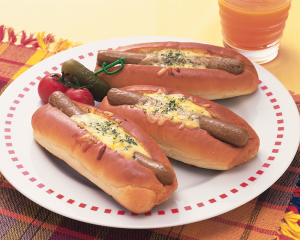 Jumbo hot dogs with the “works”: Consider normal-sized hot dogs with fewer toppings. The average hot dog is not all that caloric, especially these days with so many lower-calorie and lower-fat versions available. And while hot dogs are not exactly a nutritionist’s favorite food, they can often be a better choice at the barbecue over a hamburger blanketed with cheese or Italian sausage. The calories begin to add up, however, with larger sizes (jumbo, stadium, bun-length), heaps of toppings, and the inclination to eat more than just one. Some bruisers with chili sauce pack a whopping 400 calories. So, choose your dogs and toppings wisely. Scour labels and opt for varieties that are uncured (nitrate/nitrite free) and lower in fat, calories, and sodium. Consider alternatives to beef — chicken, turkey, veggie — and pair it with a whole grain bun. Lastly, swap some of the traditional toppings for lower-calorie salsa. My favorite? Trader Joe’s Uncured Chicken Hot Dogs. Yum.
Jumbo hot dogs with the “works”: Consider normal-sized hot dogs with fewer toppings. The average hot dog is not all that caloric, especially these days with so many lower-calorie and lower-fat versions available. And while hot dogs are not exactly a nutritionist’s favorite food, they can often be a better choice at the barbecue over a hamburger blanketed with cheese or Italian sausage. The calories begin to add up, however, with larger sizes (jumbo, stadium, bun-length), heaps of toppings, and the inclination to eat more than just one. Some bruisers with chili sauce pack a whopping 400 calories. So, choose your dogs and toppings wisely. Scour labels and opt for varieties that are uncured (nitrate/nitrite free) and lower in fat, calories, and sodium. Consider alternatives to beef — chicken, turkey, veggie — and pair it with a whole grain bun. Lastly, swap some of the traditional toppings for lower-calorie salsa. My favorite? Trader Joe’s Uncured Chicken Hot Dogs. Yum.
Barbecued pork ribs: Consider leaner meats sans sauce. Pork ribs, while delectable, have more calories and fat, including saturated fat, than most meats. A half rack of barbecuedpork ribs (about 6), for example, has anywhere from 500 to 600 calories and 30 to 40 grams of fat, a third of which are saturated. Saturated fat, as many know, has been linked to high cholesterol and heart disease. The slathered-on barbecued sauce only adds more calories. Select leaner, healthier meats — like skinless chicken or turkey, pork loin or sirloin steak — and use dry rubs for flavor over sauces.
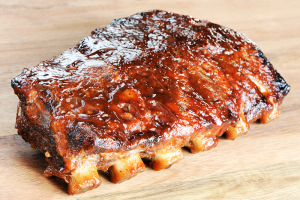 Final suggestion: Summer bursts with fresh produce in stores and at farmers markets, so take advantage of the seasonal, healthful bounty. What’s more, freezing produce is easy and preserves most of the fruit or vegetable’s nutritional content.
Final suggestion: Summer bursts with fresh produce in stores and at farmers markets, so take advantage of the seasonal, healthful bounty. What’s more, freezing produce is easy and preserves most of the fruit or vegetable’s nutritional content.
Anne Palumbo is the author of SmartBites, a food-related column published every month in In Good Health.

